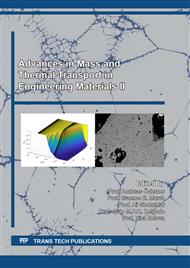[1]
E.F. Vegman, N.F. Zherebin, A.N. Pokhvisnev, Y.S. Yusfin, I.F. Kurunov, A.E. Parenkov, P.I. Chernousov, Metallurgy of pig iron, Academkniga, Moscow; (2004).
Google Scholar
[2]
A. Babich, D. Senk, H.W. Gudenau, K.Th. Mavrotnmatis, Ironmaking, RWTH Aachen University Department of Ferrous Metallurgy, (2006).
Google Scholar
[3]
A.N. Dmitriev, Analysis of blast furnace efficiency, Energy Analysis and Energy Efficiency, 4-5 (2004) 41-42.
Google Scholar
[4]
A.N. Dmitriev, R.V. Alektorov, G.Yu. Vitkina, S.A. Petrova, Yu.A. Chesnokov, Features of the reducibility of titanomagnetite iron ore materials, Defect and Diffusion Forum, 400 (2020) 176-185.
DOI: 10.4028/www.scientific.net/ddf.400.176
Google Scholar
[5]
S.A. Lipunov, Experimental study of gas permeability of cohesion zone, Journal of the Priazovsky State Technical University, 28 (2014) 37-42.
Google Scholar
[6]
V.P. Russkikh, S.A. Lipunov, Researches of influence of degree of reduction of agglomerate on temperature softening interval, Journal of the Priazovsky State Technical University, 25 (2012) 35-40.
Google Scholar
[7]
I.D. Balon, I.V. Buklan, V.N. Muravyov, Y.F. Nikulin, Phase transformations in material in blast furnace, Metallurgy, Moscow, (1984).
Google Scholar
[8]
V.P. Russkikh, S.A. Lipunov, Research of influence of softening degree of agglomerate and FeO content in it on reduction kinetics, Journal of the Priazovsky State Technical University, 26 (2013) 15-20.
Google Scholar
[9]
V.M. Parshakov, A.A. Polinov, A.V. Pavlov, A.A. Tretiak, A.V. Kolosov, I.A. Prokhorov, P.Yu. Dovzhenko, Control and optimization of melting zone parameters using two-dimensional mathematical model as a part of blast furnace process control system, Metallurgist, 7 (2017) 30-36.
DOI: 10.1007/s11015-017-0529-2
Google Scholar
[10]
V.M. Parshakov, A.A. Polinov, A.V. Pavlov, A.A. Tretiak, I.A. Prokhorov, A.V. Kolosov, P.Yu. Dovzhenko, Introduction of an automated system for control, optimization and forecasting of blast furnace smelting at MMK blast furnaces, Metallurgist, 8 (2017) 40-47.
DOI: 10.1007/s11015-017-0546-1
Google Scholar
[11]
A.A. Tretiak, V.M. Parshakov, V.A. Borisenko, Selection of the operating mode of BLT using the data on gas distribution on the grate and the shape of the melting zone in the lower part of the furnace, Metallurgist, 11 (2017) 40-46.
DOI: 10.1007/s11015-018-0592-3
Google Scholar
[12]
V.M. Parshakov, V.A. Bokovikov, F.R. Shklar, Mathematical model for the gas flow dynamics and heat and mass transfer processes in the hearth of a blast furnace and its use in the analysis of smelting, Proceedings of Int. Blast Furnace Hearth Raceway Symp., 1981, p.15.1-15.6.
DOI: 10.1007/bf00733242
Google Scholar
[13]
Y.N. Ovchinnikov, V.I. Moikin, N.A. Spirin, B.A. Bokovikov, Non-stationary processes and increasing the efficiency of blast furnace smelting, Metallurgy: Chelyabinsk Branch, Chelyabinsk, (1989).
Google Scholar
[14]
A.N. Dmitriev, Mathematical modelling of blast furnace process, UB RAS, Ekaterinburg, (2011).
Google Scholar
[15]
L.F. Alekseev, A.V. Chentsov, S.D. Abramov, S.V. Shavrin, Experimental study of reduction and melting processes of Kachkanarsky agglomerate, Reduction, Heat Exchange and Hydrodynamics in a Blast Furnace Process: Proceedings of the Institute of Metallurgy, 28 (1972) 48-76.
Google Scholar
[16]
A.N. Dmitriev, Yu.A. Chesnokov, G.Yu. Arzhadeeva, The coke and iron ore materials kinetic characteristics and quantitative indicators of blast furnace process, Defect and Diffusion Forum, 322 (2012) 87-106.
DOI: 10.4028/www.scientific.net/ddf.322.87
Google Scholar
[17]
A.N. Dmitriev, G.Yu. Vitkina, Yu.A. Chesnokov, Methodical basis of investigation of influence of the iron ore materials and coke metallurgical characteristics on the blast furnace smelting efficiency, Advanced Materials Research, 602-604 (2013) 365-375.
DOI: 10.4028/www.scientific.net/amr.602-604.365
Google Scholar
[18]
G.Yu. Vitkina, A.N. Dmitriev, R.V. Alektorov, Study of the main metallurgical characteristics of iron ore raw materials (sinter and pellets), IOP Conference Series: Materials Science and Engineering, 966(1) (2020) 012061.
DOI: 10.1088/1757-899x/966/1/012061
Google Scholar


